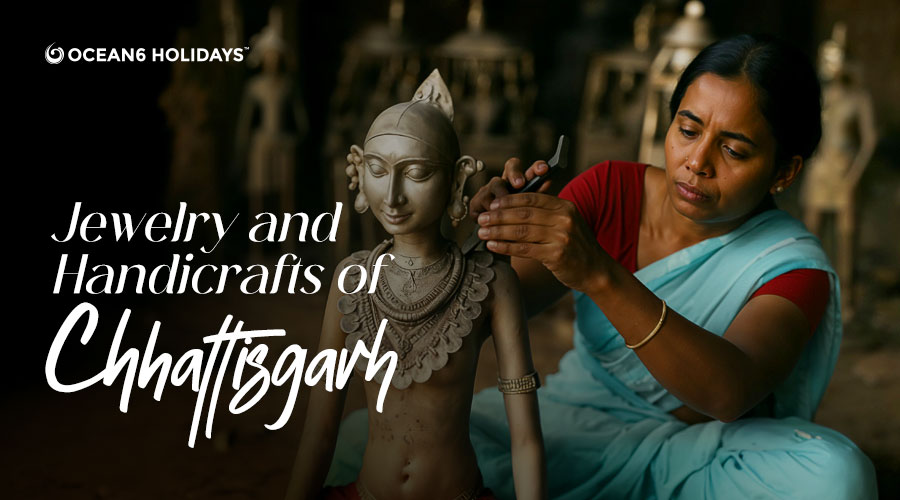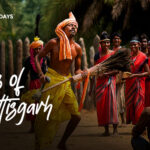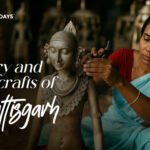A Journey Through Tribal Elegance and Artistic Heritage
Chhattisgarh, often called the cultural heart of central India, is a treasure trove of indigenous artistry, where every bead, carving, weave, and metalwork tells a story of tradition and craftsmanship. The state’s jewellery and handicrafts are not just decorative pieces-they are living symbols of tribal identity, heritage, and spirituality.
From the rhythmic clang of hammers shaping iron into art, to the intricate loom work of Kosa silk, to the bold and colourful tribal ornaments, the craftsmanship of Chhattisgarh is deeply rooted in the lives of its people. Travellers who wander into this land find themselves immersed in a vibrant marketplace of creativity, with each region offering something unique.
In this blog, we explore the jewellery, textiles, and handicrafts of Chhattisgarh-diving deep into their history, techniques, and cultural significance.
1. Tribal Jewellery of Chhattisgarh – Ornaments with Soul
Jewellery in Chhattisgarh goes far beyond adornment-it is a statement of social identity, status, and community pride. Both men and women wear ornaments, but during festivals and special occasions, it is often the men who are more elaborately bedecked.
Most tribal ornaments are made from natural and locally available materials like beads from bones, seeds, and wood, worn as laces, ropes, fillets, and collars. The craftsmanship extends to gold, silver, bronze, and mixed metals.
- Gold Jewellery: Traditionally worn by men to signify prestige in the village, gold is often placed on the ear, nose, and neck.
- Silver Jewellery: Worn as hoops on the neck, solid or tubular bracelets on the wrist, and square-bar anklets around the legs.
- Unique Designs: Conical twin-tops for nostrils and ear lobes, rings for the ear’s helix, and red wool tassels still worn by both men and women of the Hill-Maria tribe.
- Beads & Cowries: Embellished with feathers and vibrant colours, they add a lively texture to the festive atmosphere.
Where to find them: These ornaments can be bought in haat bazaars across the state, where artisans display their work in a carnival-like setting.
Tourist can stay and experience at STF Camp Resort , Karma Ethnic Resort.
2. Costumes of Chhattisgarh – Threads of Identity
The tribal costumes of Chhattisgarh are a colourful display of the region’s ethnic diversity. Men from tribal communities like the Marias, Murias, Halbas, and Abhuj Marias wear dhotis and headgear like cotton turbans, while women wear knee-length or full-length bright sarees.
Fabric varieties include:
- Maheshwari silk
- Orissa silk
- Chanderi silk
- Batik print sarees
These costumes are particularly striking during festivals, when peacock feathers, chunky wooden or metal ornaments, and bead jewellery add to the visual spectacle. The designs often incorporate beadwork, cowries, and feathers, making each outfit a vibrant statement of cultural pride.
Tourist can stay and experience at Hotel Johar, Hareli Eco Resort.
3. Bamboo Craft – Nature Woven into Art
Bamboo grows abundantly in Chhattisgarh’s forests, making it a versatile raw material for tribal communities. The skilled Kamars of Raipur craft everything from bows, arrows, hunting tools, bird traps, and fishing equipment to household items like fences and baskets.
The Narayanpur Bamboo Project has modernised the craft by providing state-of-the-art workshops and accommodation for artisans, ensuring that the tradition thrives while meeting modern demands. This initiative also produces unique items like the famous bamboo whistle invented by Pandi Ram Mandavi.
Tourist can stay and experience at Dandami Luxury Resort, STF Camp Resort, Karma Ethnic Resort.
4. Painting – Rituals on Walls
Tribal wall paintings in Chhattisgarh are a visual extension of local traditions and rituals. Painted with natural colours, these artworks decorate floors, walls, and even household objects, especially during weddings, childbirth, and festivals.
These paintings, originating in central India (now Madhya Pradesh and Chhattisgarh), often depict offerings to gods and stories of creation. Their charm lies in their raw, earthy execution—using colours derived from minerals, plants, and soil.
Tourist can stay and experience at Hotel Johar, Hareli Eco Resort, Sarna Ethnic Resort.
5. Clay Pottery and Terracotta – Earth Shaped into Heritage
Chhattisgarh’s terracotta artistry dates back to 7000 BC, making it one of the oldest craft traditions in the region. The clay from the Indravati River is moulded by Kumhars (potters) into everything from simple kitchenware to elaborate sculptures.
Over time, terracotta has expanded beyond utility items to include:
- Masks for festivals like Cher Chhera
- Animal and human figurines
- Decorative lamps and diyas like the famous Mata Diya of Sarguja
Each piece is sun-dried, fired, and sometimes painted, resulting in warm, earthy tones that symbolise rural simplicity.
Tourist can stay and experience at Sarna Ethnic Resort.
6. Wood Carving – Carving Stories in Timber
The Badhai tribe is renowned for its woodcraft, passed down through generations. The carvings range from practical items like pillars, bows, and farm implements to spiritual artefacts like Mata Jhulna (swinging goddess idols).
Figures of birds, animals, gods, and humans are meticulously shaped, polished, and sometimes painted. Regions like Raigarh and Sarguja are particularly well known for this craft.
Tourist can stay and experience at Hotel Johar, Hareli Eco Resort.
7. Iron Craft – Strength Forged in Fire
The lohar community of Kondagaon village in Bastar has perfected the art of shaping hot iron into decorative and functional items. Without casting or moulding, the metal is beaten, cut, and filed into form.
Common creations include:
- Farm tools
- Lamps
- Decorative artefacts
- Hollow sculptures from beaten iron sheets
The rhythmic hammering in village forges is a sound that has resonated for centuries across Chhattisgarh’s craft villages.
Tourist can stay and experience at Dandami Luxury Resort, STF Camp Resort.
8. Bell Metal Craft – The Timeless Dokra Art
One of Chhattisgarh’s most famous exports, Dokra art, uses the lost wax casting method to create bell metal artefacts from brass and bronze. Practised by tribes like the Ghadwas of Bastar and Jharas of Raigarh, this craft produces:
- Ornamental figures
- Animal sculptures
- Decorative household objects
Internationally acclaimed artisans like Jaidev Baghel and Sushil Sakuja have elevated this art to global recognition, exhibiting works in countries like Russia, Germany, and Japan.
Tourist can stay and experience at Dandami Luxury Resort , STF Camp Resort.
9. Stone Carving – Sculpting the Spirit of Bastar
The sudapaal stone of Bastar is soft and easy to carve, making it ideal for intricate sculptures. Artisans use chisels of various shapes, free-hand carving skills, and polishing techniques to create both two-dimensional relief work and three-dimensional idols.
Tatiya saaj idols are particularly striking, carved with precision and proportion without formal measurements, relying instead on inherited skill.
Tourist can stay and experience at Hotel Johar, Hareli Eco Resort, Dhankul Ethnic Resort, Sarna Ethnic Resort.
10. Tattooing – Marks of Identity
Among the Adivasi tribes of Chhattisgarh, tattooing is a deeply symbolic practice. The marks are often created at a young age and represent:
- Status within the community
- Security in the afterlife (as tattoos are believed to be the only possessions taken after death)
However, tattoos are never placed on the waist or hips, and post-marriage tattooing is considered inauspicious.
Tourist can stay and experience at Baiga Ethnic Chilpi, Sarna Ethnic Resort.
11. Fabrics of Chhattisgarh – Weaving Dreams in Silk
The Kosa silk (also known as Tussar) of Chhattisgarh is world-renowned for its durability, natural sheen, and earthy colours like cream, honey, and beige. Sourced from cocoons grown on arjun and sal trees, this silk is turned into saris, shawls, jackets, and lehengas.
Notable techniques include:
- Kantha embroidery
- Fera and jaala weaves
- Block printing and mirror work
In Raigarh and Champa, weaving has become a heritage industry, producing some of the most sought-after silks in India.
Tourist can stay and experience at Sarna Ethnic Resort, Dhankul Ethnic Resort, Kurdar Hill Eco Resort.
12. Stone, Beads, and Bones – Everyday Artisanship
Beyond the major crafts, Chhattisgarh’s artisans create countless small but meaningful items from local stones, beads, and bones. These are fashioned into combs, hairpins, and miniature sculptures, often sold at local markets as affordable keepsakes for travellers.
Tourist can stay and experience at Sonbhadra Tourist Resort, Eco Hill Resort.
Why Travellers Love Chhattisgarh’s Jewellery and Handicrafts
For tourists, shopping in Chhattisgarh is not just about buying souvenirs-it’s about owning a piece of living culture. Whether it’s a silver anklet from a tribal market, a bamboo basket from Narayanpur, or a bell metal sculpture from Bastar, each piece carries the soul of its maker.
The crafts are more than objects-they are connections to ancient traditions, rural livelihoods, and sustainable practices that have stood the test of time.
Travel Tip: Where to Shop
- Shabari Handicrafts Emporium, Raipur – For government-certified handicrafts.
- Weekly Haat Bazaars – For authentic tribal jewellery and pottery.
- Narayanpur Bamboo Craft Clusters – For innovative bamboo items.
- Bastar Craft Villages – For bell metal, wood, and iron artefacts.
Final Word:
Chhattisgarh’s jewellery and handicrafts are not just art forms-they are echoes of history and symbols of resilience. Every item carries a story that began in a humble tribal home and travelled through generations. For travellers, bringing home a piece from Chhattisgarh is bringing home a piece of India’s heart.






